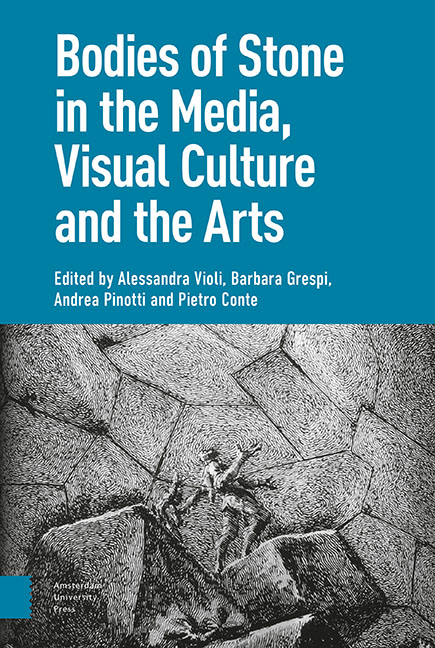Book contents
- Frontmatter
- Contents
- Introduction: Learning from Stone
- I Statue: The Imaginary of Uncertain Petrification
- 1 Theatre and Memory: The Body-as-Statue in Early Modern Culture
- 2 Translated Bodies: A ‘Cartographic’ Approach
- 3 Pantomime in Stone: Performance of the Pose and Animal Camouflage
- 4 Animated Statues and Petrified Bodies: A Journey Inside Fantasy Cinema
- 5 The Ephemeral Cathedral: Bodies of Stone and Configurations of Film
- II Matter: Size, Hardness, Duration
- 1 Bodies That Matter: Miniaturisation and the Origin(s) of ‘Art’
- 2 Brancusi’s ‘Sculpture for the Blind’
- 3 Cinema, Phenomenology and Hyperrealism
- 4 Ephemeral Bodies: The ‘Candles’ of Urs Fischer
- 5 The Celluloid and the Death Mask: Bazin’s and Eisenstein’s Image Anthropology
- III Corpse: Fossils, Auto-Icons, Revenants
- 1 Funeral Eulogy: Post-Mortem Figures and Redeemed Bodies, in Images
- 2 On Jack Torrance As a Fossil Form
- 3 Technical Images and the Transformation of Matter in Eighteenth-Century Tuscany
- 4 Glass, Mixed Media, Stone: The Bodily Stuffs of Suspended Animation
- 5 Bodies’ Strange Stories: Les Revenants and The Leftovers
- IV Monument: Embodying and Grafting
- 1 The Impassibly Fleshly, the Statue of the Impossible
- 2 Frozen into Allegory: Cleopatra’s Cultural Survival
- 3 The Orphan Image
- 4 The Well-Tempered Memorial: Abstraction, Anthropomorphism, Embodiment
- 5 Monuments of the Heart: Living Tombs and Organic Memories in Contemporary Culture
- Index
1 - Bodies That Matter: Miniaturisation and the Origin(s) of ‘Art’
Published online by Cambridge University Press: 20 November 2020
- Frontmatter
- Contents
- Introduction: Learning from Stone
- I Statue: The Imaginary of Uncertain Petrification
- 1 Theatre and Memory: The Body-as-Statue in Early Modern Culture
- 2 Translated Bodies: A ‘Cartographic’ Approach
- 3 Pantomime in Stone: Performance of the Pose and Animal Camouflage
- 4 Animated Statues and Petrified Bodies: A Journey Inside Fantasy Cinema
- 5 The Ephemeral Cathedral: Bodies of Stone and Configurations of Film
- II Matter: Size, Hardness, Duration
- 1 Bodies That Matter: Miniaturisation and the Origin(s) of ‘Art’
- 2 Brancusi’s ‘Sculpture for the Blind’
- 3 Cinema, Phenomenology and Hyperrealism
- 4 Ephemeral Bodies: The ‘Candles’ of Urs Fischer
- 5 The Celluloid and the Death Mask: Bazin’s and Eisenstein’s Image Anthropology
- III Corpse: Fossils, Auto-Icons, Revenants
- 1 Funeral Eulogy: Post-Mortem Figures and Redeemed Bodies, in Images
- 2 On Jack Torrance As a Fossil Form
- 3 Technical Images and the Transformation of Matter in Eighteenth-Century Tuscany
- 4 Glass, Mixed Media, Stone: The Bodily Stuffs of Suspended Animation
- 5 Bodies’ Strange Stories: Les Revenants and The Leftovers
- IV Monument: Embodying and Grafting
- 1 The Impassibly Fleshly, the Statue of the Impossible
- 2 Frozen into Allegory: Cleopatra’s Cultural Survival
- 3 The Orphan Image
- 4 The Well-Tempered Memorial: Abstraction, Anthropomorphism, Embodiment
- 5 Monuments of the Heart: Living Tombs and Organic Memories in Contemporary Culture
- Index
Summary
Abstract Small things matter, especially in the so-called ‘arts’. From the visual arts to music and literature, ‘miniatures’ are a transcultural and transhistorical phenomenon that involves our aesthetic attitudes but also our everyday life, our emotional, social and cognitive life. Miniaturisation characterises our cognitive life and, of course, the ‘cognitive life of things’ that we produce, manipulate and discard. My paper is articulated into two sections: the first gives a quick overview of the miniatures of Homo sapiens, especially those of the paleolithic age, and a brief survey of the very challenging history of miniature-interpretation in twentieth-century philosophy of culture. In the second part I focus on five cognitive interpretations of miniature, which are supported by some experimental evidence.
Keywords: Miniaturization; paleolithic figurines; perceptual primitives; off-line cognition; animism; liberated embodied simulation
The miniature, then, is an attempt to reproduce the universe in graspable form. It represents a desire to possess the world more completely, to banish the unknown and the unseen. We are teased out of the world of terror and death and under the enchantment of the miniature we are invited to become God.
‒ Steven MillhauserSmall things matter, especially in the so-called ‘arts’. From the visual arts to music and literature, ‘miniatures’ are a transcultural and transhistorical phenomenon that involves our aesthetic attitudes but also our everyday life, our emotional, social and cognitive life. Miniaturisation characterises our cognitive life and, of course, the ‘cognitive life of things’ that we produce, manipulate and discard. We can study miniaturisation as a particular way of handling things that characterises the whole evolution of Homo sapiensand, to the same degree, all human cognition.
In a certain sense, we could say that all ‘art’ is a kind of miniaturisa-tion—from palaeolithic Venuses to Japanese netsuke, from bonsaito Chinese micro-mountains, from miniature portraits to daguerrotypes and stereoscopies. I use the compromised term ‘art’ as a provocation only to challenge our aesthetic theories because, like Tim Ingold, I am con-vinced that in order to study miniatures it is much better to move outside the history of representation or to concentrate on ‘the material form of representation’—as Randall White puts it—especially if we consider the ‘aesthetic behaviour’ of Homo sapiensin the wider context of ethology and evolutionary theory.
- Type
- Chapter
- Information
- Bodies of Stone in the Media, Visual Culture and the Arts , pp. 133 - 158Publisher: Amsterdam University PressPrint publication year: 2020



